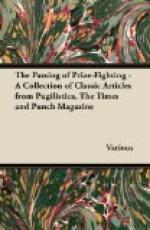A highly important and interesting survey of the coast
between Arundel-stairs and Hungerford-market pier,
is now being executed, under the superintendence of
Bill Bunks, late commander of the coal-barge “Jim
Crow.” The result of his labours hitherto
have been of the most interesting nature to the natural
historian, the antiquarian, and the navigator.
In his first report to the magistrates of the Thames-police,
he states that he has advanced in his survey to Waterloo-bridge
stairs, which he describes as a good landing-place
for wherries, funnies, and small craft, but inadequate
as a harbour for vessels of great burthen. The
shore from Arundel-street, as far as he has explored,
consists chiefly of a tenacious, dark-coloured substance,
very closely resembling thick mud, intermixed with
loose shingles, pebbles, and coal-slates. The
depth of water is uncertain, as it varies with the
tide, which he ascertains rises and falls every six
hours; the greatest depth of water being usually found
at the time when the tide is full in, and vice versa.
He has also made the valuable discovery, that a considerable
portion of the shore is always left uncovered at low
water, at which periods he availed himself of the
opportunity afforded him of examining it more minutely,
and of collecting a large number of curious specimens
in natural history, and interesting antiquarian relics.
As we have had the privilege of being permitted to
view them in the private museum of the “Stangate-and-M
ilbank-both-sides-of-the-water-united-for-the-advancement-of-Science-Association,”
we are enabled to lay before our readers the particulars
of a few of these spoils, which the perseverance and
intrepidity of our gallant countryman, Bill Bunks,
has rescued from the hungry jaws of the rapacious
deep; viz.:—
1. “A case of shells.” The greater number of the specimens are pronounced, by competent judges, to be shells of the native oyster; a fact worthy of note, as it proves the existence, in former ages, of an oyster-bed on this spot, and oysters being a sea-fish, it appears evident that either the sea has removed from London, or London has withdrawn itself from the sea. The point is open to discussion. We hope that the “Hookham-cum-Snivey Institution” will undertake the solution of it at one of their early meetings.
2. “The neck of a black bottle, with a cork in it.” This is a very interesting object of art, and one which has given rise to considerable discussion amongst the literati. The cork, which is inserted in the fragment of the neck, is quite perfect; it has been impressed with a seal in reddish-coloured wax; a portion of it remains, with a partly obliterated inscription, in Roman characters, of which we have been enabled to give the accompanying fac-simile.
[Illustration]




